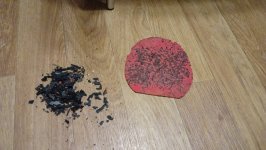This user has no status.
This user has no status.
Well-Known Member
In the Paddle Palace catalog #307, on page 66, there is an article that was cobbled together with input from so called Andro and Tibhar experts. These "experts" are clearly just marketing people, not experts.
The article is about choosing the correct sponge hardness. There are 5 questions.
1. "why does sponge hardness matter?"
2. "What is the difference in performance from a rubber that has a soft sponge, medium sponge, or a hard sponge?"
3. "Why would I, as a player, choose a harder or softer sponge?"
4. "What is the most important consideration for which kind of rubber I should use?"
5. "How should my choice of sponge hardness be affected by my style of play, how far back I stand from the table, what type of rubber I use (smooth, short pips, longpips), and my level of expertise, or other factors?"
The answers are long but the over all theme is that soft sponges are for beginners and hard sponges are for experts. The answer attributed features like speed, spin and control to the hardness of the rubber. This is nonsense. Speed and spin is a function of the rubbers elasticity. There can be hard dead rubbers or soft dead rubbers. These types of sponges are on anti rubbers. There can be springy hard and soft rubbers too.
We all know that the hardness is measured in durometers. Although it is easy to find how much force it takes to make an indentation, there is no measure of elasticity or how long it takes for the rubber to spring back to the original shape after the indenting force is removed. Hardness or softness cannot be directly equated to springiness. This is fact.
I think the "experts" need to go back an read the story about Goldilocks and the Three Bears. Some rubbers will be too soft and may even "bottom out" and some rubbers will be too hard ( Why don't the pros use SST Pro Team, it is very hard. Why do they want to make the hard rubbers softer by boosting? ). Most of us are like Goldilocks. We want a rubber that is not to hard and not too soft, but just right.
So overall I would forget what the so called "experts" have to say. Get what works for you.
Now for the geek speak.
Harder rubbers absorb less energy than soft rubbers. If they absorb less energy then they will return less energy If you look at a cm^2 of rubber as a spring you will see the amount of energy absorbed is roughly proportional the distance the rubber is compressed squared. E = k*Δx^2. Harder rubbers will have a higher value for the spring constant k but lower values for compression distance Δx. When the rubber decompresses the rubber will push the ball back most of that compression distance. That fraction of the compression distance, where the rubber is still pushing the ball, divided by the time is the extra speed or trampoline affect that gets added to the paddle speed.
Something that must be considered it that the ball must accelerate the mass of the top sheet and sponge between the ball and sponge. When the rubber springs back it must accelerate not only the ball but also the mass of the compressed sponge. The energy that is required to accelerate the sponge is lost. So there is a trade off between hard and soft rubbers. Harder rubbers will not compress much so the trampoline effect will be small. Soft rubbers may not spring back fast enough to keep up with the ball so again a lot of the trampoline effect is lost. There is a happy medium but it will not be the same for every body and for every condition.
What is interesting is that people talk about dwell time of the rubber and seem to blindly state they want more dwell time. If the time it takes the rubber to spring back is longer then the trampoline effect is reduced. Again, there is a Goldilocks zone.
It should be clear I don't see this as a hard vs soft issue but more of a what is just right for you issue.
The article is about choosing the correct sponge hardness. There are 5 questions.
1. "why does sponge hardness matter?"
2. "What is the difference in performance from a rubber that has a soft sponge, medium sponge, or a hard sponge?"
3. "Why would I, as a player, choose a harder or softer sponge?"
4. "What is the most important consideration for which kind of rubber I should use?"
5. "How should my choice of sponge hardness be affected by my style of play, how far back I stand from the table, what type of rubber I use (smooth, short pips, longpips), and my level of expertise, or other factors?"
The answers are long but the over all theme is that soft sponges are for beginners and hard sponges are for experts. The answer attributed features like speed, spin and control to the hardness of the rubber. This is nonsense. Speed and spin is a function of the rubbers elasticity. There can be hard dead rubbers or soft dead rubbers. These types of sponges are on anti rubbers. There can be springy hard and soft rubbers too.
We all know that the hardness is measured in durometers. Although it is easy to find how much force it takes to make an indentation, there is no measure of elasticity or how long it takes for the rubber to spring back to the original shape after the indenting force is removed. Hardness or softness cannot be directly equated to springiness. This is fact.
I think the "experts" need to go back an read the story about Goldilocks and the Three Bears. Some rubbers will be too soft and may even "bottom out" and some rubbers will be too hard ( Why don't the pros use SST Pro Team, it is very hard. Why do they want to make the hard rubbers softer by boosting? ). Most of us are like Goldilocks. We want a rubber that is not to hard and not too soft, but just right.
So overall I would forget what the so called "experts" have to say. Get what works for you.
Now for the geek speak.
Harder rubbers absorb less energy than soft rubbers. If they absorb less energy then they will return less energy If you look at a cm^2 of rubber as a spring you will see the amount of energy absorbed is roughly proportional the distance the rubber is compressed squared. E = k*Δx^2. Harder rubbers will have a higher value for the spring constant k but lower values for compression distance Δx. When the rubber decompresses the rubber will push the ball back most of that compression distance. That fraction of the compression distance, where the rubber is still pushing the ball, divided by the time is the extra speed or trampoline affect that gets added to the paddle speed.
Something that must be considered it that the ball must accelerate the mass of the top sheet and sponge between the ball and sponge. When the rubber springs back it must accelerate not only the ball but also the mass of the compressed sponge. The energy that is required to accelerate the sponge is lost. So there is a trade off between hard and soft rubbers. Harder rubbers will not compress much so the trampoline effect will be small. Soft rubbers may not spring back fast enough to keep up with the ball so again a lot of the trampoline effect is lost. There is a happy medium but it will not be the same for every body and for every condition.
What is interesting is that people talk about dwell time of the rubber and seem to blindly state they want more dwell time. If the time it takes the rubber to spring back is longer then the trampoline effect is reduced. Again, there is a Goldilocks zone.
It should be clear I don't see this as a hard vs soft issue but more of a what is just right for you issue.















